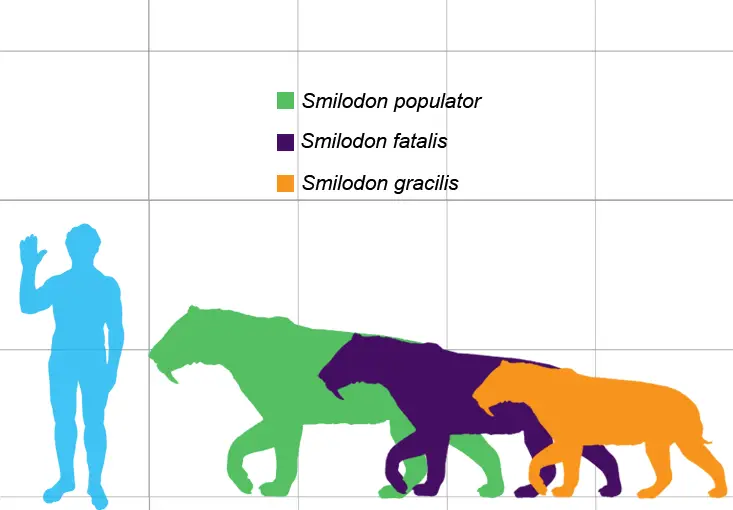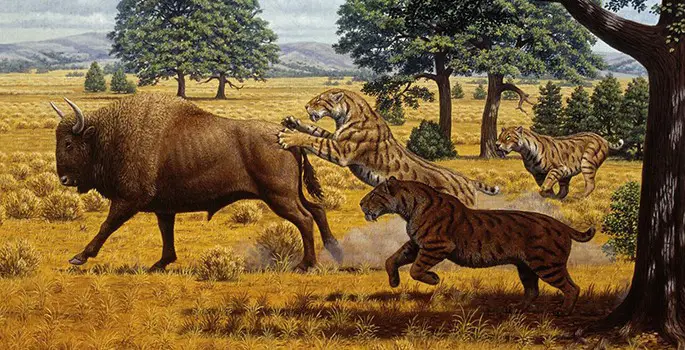Imagine stepping back in time, millions of years ago, to a world where extraordinary creatures roamed the Earth. Among these amazing animals was the saber-toothed tiger, also known as Smilodon. Now, you might picture a giant cat with long, sharp teeth, and you’re right! The saber-toothed tiger was famous for its impressively long canine teeth that looked like giant swords.
But there’s so much more to learn about these fascinating creatures! In this journey, we’re going to explore the life cycle of the saber-toothed tiger – from the moment they were born as tiny cubs to becoming powerful hunters as adults.

Let’s start this exciting adventure and discover the world of the saber-toothed tigers, understanding how they grew up, lived, and roamed our ancient planet. Stay tuned as we uncover the secrets of their life, step by step!
Life Cycle of the Saber Tooth Tiger
Birth and Early Life
Gestation Period and Birth Process
The journey of a saber-toothed tiger began even before it saw the world. Just like many animals today, saber-toothed tigers started their lives growing inside their mothers. Scientists believe that the gestation period, which is the time a baby spends growing inside its mother before being born, was about the same as modern big cats, likely around 3 to 4 months.
When the time came, a mother saber-toothed tiger would find a safe and quiet place, perhaps in a cave or thick underbrush, to give birth. The number of cubs born at one time varied, but typically, there might be two or three cute, tiny cubs in a litter. These cubs were born blind and utterly dependent on their mother, just like lion or tiger cubs today.
Early Development of Cubs and Parental Care
The first few weeks of a saber-toothed tiger cub’s life were critical. They relied on their mother for everything – warmth, protection, and food. The mother would nurse her cubs with her milk, which was rich in nutrients to help them grow strong and healthy.

As the cubs grew a bit older, their eyes would open, and they would start to explore their surroundings, always under the watchful eye of their mother. Saber-toothed tiger cubs were playful, which was crucial for their development. By playing, they learned important skills like how to pounce and how to use their claws – all essential for their survival in the wild.
Mothers were incredibly protective of their cubs. They would fiercely defend them against any threats and teach them how to hunt and survive. There’s evidence that suggests saber-toothed tigers lived in groups, so it’s possible that older siblings or other group members also played a role in looking after the cubs.
This early stage of life, full of learning and growth, set the foundation for the cubs to become mighty predators of their time. They gradually transitioned from being dependent on their mother’s milk to eating meat, beginning their journey from playful cubs to powerful hunters.
Juvenile Stage
Growth Patterns from Cub to Juvenile
As saber-toothed tiger cubs grew older, they entered what we call the ‘juvenile stage’. This stage marked a significant growth spurt. Within their first year, these cubs would rapidly gain weight and size. Their distinctive long canine teeth, which were small at birth, began to grow and become more pronounced. These teeth, however, wouldn’t reach their full size until they were adults.
During this time, the juveniles would start to look more like miniature versions of their parents, with stronger muscles and a more defined appearance. Their coats, which were initially softer and more cub-like, would become thicker and more rugged, preparing them for life in the wild.
Learning to Hunt and Socialize
One of the most crucial aspects of the juvenile stage was learning essential life skills. Hunting was at the top of this list. Initially, the juveniles would observe their mother or other adult members of the group hunting. They would watch and learn how to stalk prey, how to use their strength, and, most importantly, how to use their unique saber teeth effectively.
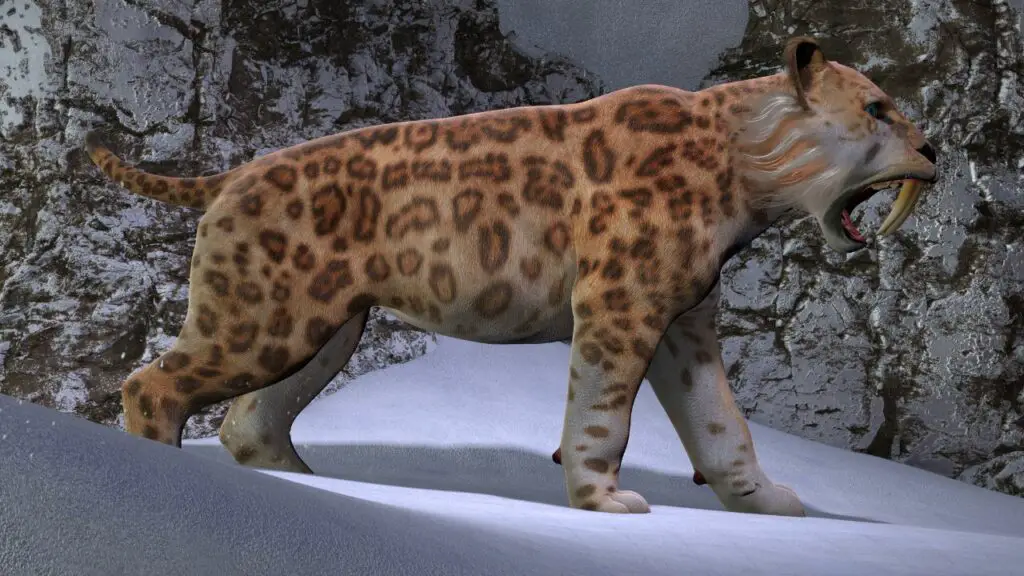
As they got older, they would start participating in hunts. These initial hunting attempts were likely not very successful, but they provided invaluable lessons. Through trial and error, play, and imitation, these young saber-toothed tigers honed their skills.
Socializing was another key aspect of their development. If saber-toothed tigers lived in groups, as some evidence suggests, then learning how to interact with other members of their species was crucial. This socialization included understanding their place in the group, how to communicate with others, and how to cooperate during hunts.
This stage of life was a busy one for saber-toothed tiger juveniles. They were growing rapidly, learning to hunt, and figuring out how to be a part of their social world. These years were filled with learning and adventure, preparing them for the next big step in their lives: becoming adults.
Adulthood
Physical and Behavioral Characteristics of Adult Saber-Toothed Tigers
Reaching adulthood was a significant milestone for a saber-toothed tiger. Adult saber-toothed tigers were magnificent and powerful creatures, standing out with their robust build and, most notably, their elongated canine teeth. These teeth could grow up to 7 inches long, becoming the defining feature of their appearance.
Adults typically weighed between 200 to 600 pounds, with males generally being larger and heavier than females. Their bodies were muscular and strong, well-suited for overpowering large prey. Their limbs, while shorter and stockier compared to modern big cats, provided them with explosive power, essential for their ambush hunting style.
Behaviorally, adults were skilled hunters, having perfected the art of stalking and using their powerful jaws and teeth effectively. While there is ongoing debate among scientists, some evidence suggests that saber-toothed tigers may have hunted in packs, coordinating their attacks for a more effective kill.

Mating Behaviors and Rituals
Mating was an important part of the saber-toothed tiger’s life cycle. While not much is known about their specific rituals, it’s likely that they followed patterns similar to other large cats. Males would compete for the attention of females, possibly through displays of strength or loud vocalizations.
Females, when in estrus, would signal their readiness to mate through scent marking and possibly specific calls or behaviors. Mating would occur during specific seasons, ensuring that the birth of cubs would align with times when food was abundant, thus maximizing the cubs’ chances of survival.
The social structure of saber-toothed tigers during the mating season is still a subject of research. Whether they formed lasting pair bonds or if males competed each season for different females remains a mystery. However, it is clear that mating and reproduction were vital for the continuation of the species.
In adulthood, saber-toothed tigers stood at the pinnacle of their strength and prowess. This stage of their life was marked by mastery in hunting, contributing to the survival of their species through reproduction, and maintaining their role as one of the most iconic predators of their time.
Aging and Lifespan
Average Lifespan and Signs of Aging
The lifespan of a saber-toothed tiger in the wild is a subject of some speculation, as direct observations were obviously not possible. However, based on fossil evidence and comparisons with modern big cats, scientists estimate that saber-toothed tigers likely lived for about 20 to 40 years.
As these magnificent creatures aged, they would exhibit signs similar to what we see in elderly animals today. Their movements might become less swift, and their reflexes could slow down. The wear and tear on their iconic saber teeth would be evident, with some teeth possibly showing significant damage or wear from years of hunting.
Older saber-toothed tigers might have had scars and other signs of past battles or encounters, telling the story of a life spent surviving in a challenging environment. Their fur might begin to show signs of graying, much like how human hair changes with age.
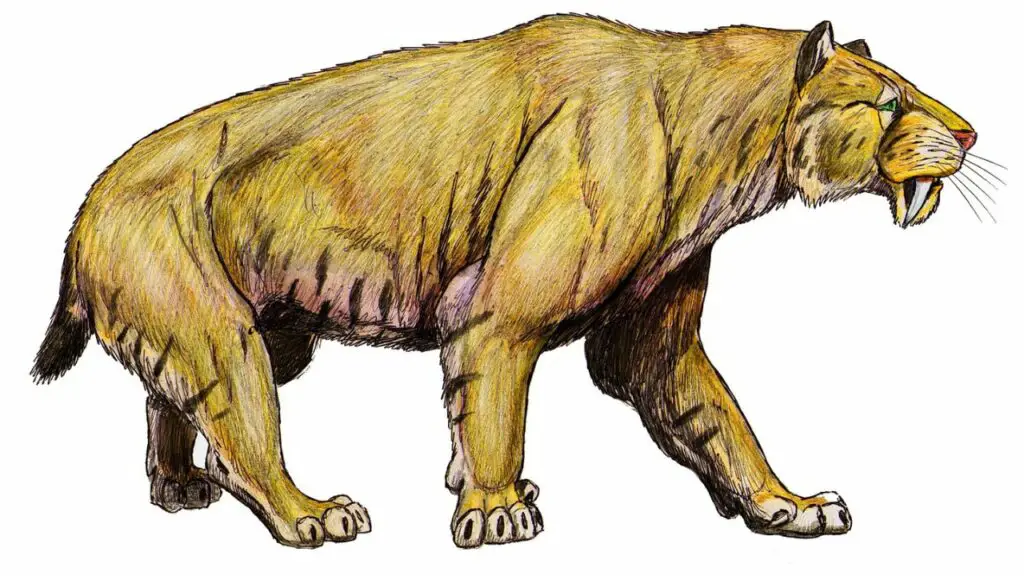
Role of Older Individuals in the Species
The role of older saber-toothed tigers within their social groups is intriguing to consider. In species with social structures, elder members often hold a crucial place, contributing through their experience and knowledge. For saber-toothed tigers, this might have meant guiding younger members in hunting techniques or social behaviors.
In cases where older individuals became less capable of hunting, they might have relied more on the group for food and protection. This dependency could have created a dynamic where the strength of the group played a vital role in the survival of each member, regardless of age.
It’s also possible that older saber-toothed tigers played a part in caring for or teaching cubs, passing on vital survival skills to the next generation. Such intergenerational interactions would have been essential for the transmission of knowledge and practices in the absence of human-like language.
As saber-toothed tigers aged, their experience and wisdom gained over years of survival could have been a valuable asset to their groups, contributing to the overall resilience and adaptability of their species.
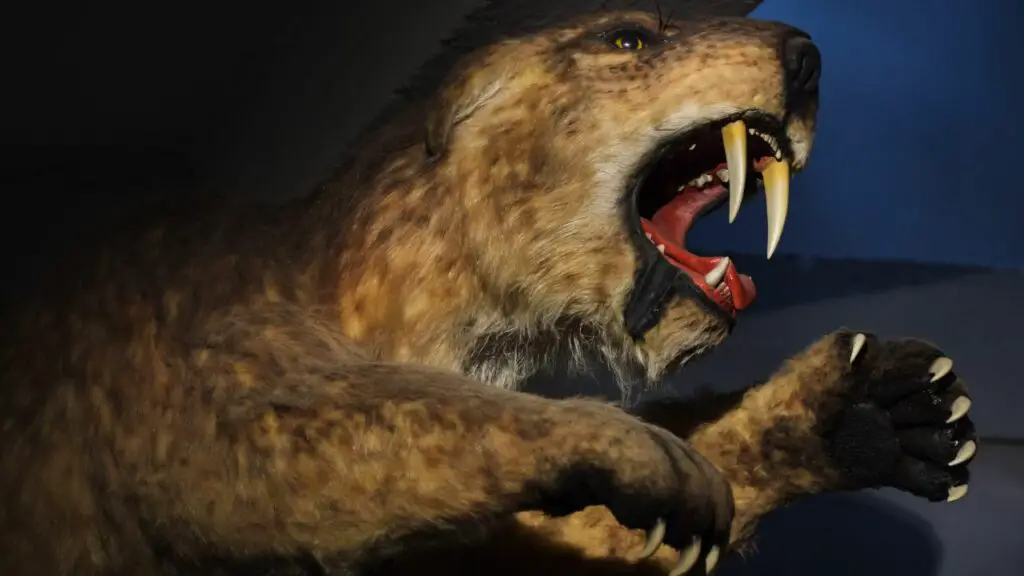
Summary of Life Cycle of the Saber Tooth Tiger
The life cycle of the saber-toothed tiger, a magnificent and iconic prehistoric predator, reveals a fascinating journey from a vulnerable cub to a formidable adult. Each stage of their life, from birth, through the juvenile phase, into adulthood, and finally aging, tells a story of adaptation and survival in a world vastly different from our own.
Birth and Early Life: This journey began with saber-toothed tiger cubs being born blind and helpless, utterly dependent on their mother for nourishment and protection. This early phase was crucial for their development, as they learned basic survival skills and began to understand their environment.
Juvenile Stage: As they grew into juveniles, these young tigers experienced rapid physical growth and honed their skills. This period was marked by learning to hunt and socialize, preparing them for the challenges of adult life.
Adulthood: In adulthood, saber-toothed tigers reached their peak in strength and hunting prowess. They displayed remarkable physical characteristics, especially their iconic saber teeth, and engaged in complex mating behaviors. This stage was critical for the continuation of their species.
Aging and Lifespan: As they aged, these tigers showed signs of wear and likely played changing roles in their social groups. The wisdom and experience of older individuals could have been essential in the survival and education of younger members.
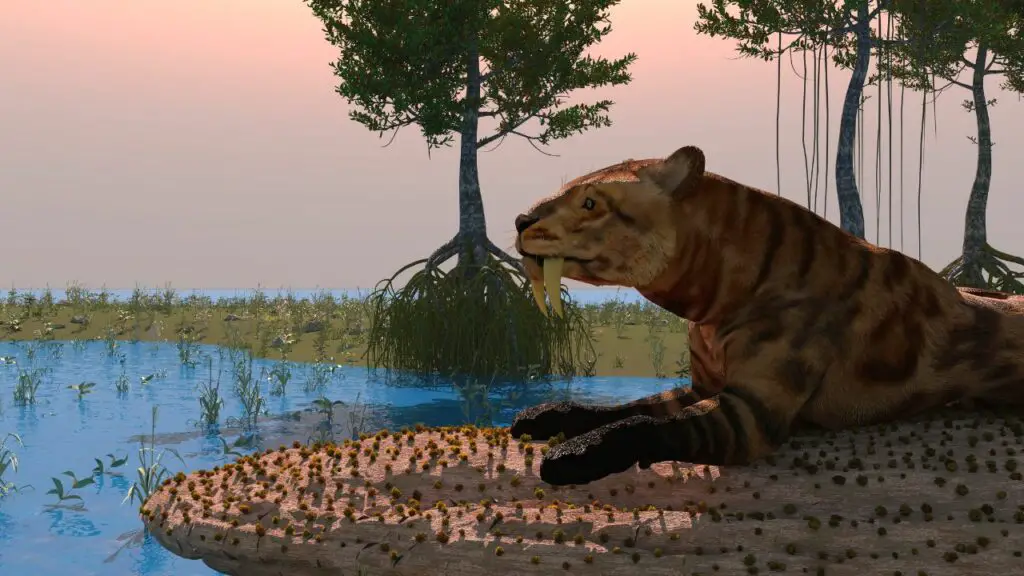
Understanding the life cycle of the saber-toothed tiger provides us with invaluable insights into this extinct species. It highlights their adaptability, the challenges they faced in their natural habitat, and their eventual extinction. By studying their life cycle, we gain a deeper appreciation of the complexity of prehistoric ecosystems and the interconnectedness of various species within them.
The saber-toothed tiger, with its distinct characteristics and fascinating life journey, remains a symbol of the diversity and wonder of ancient wildlife. Its story not only captivates our imagination but also underscores the importance of studying and preserving the rich tapestry of life on our planet, past and present.

